Red dot sights and magnifiers are popular accessories in the world of firearms. They allow shooters to aim accurately and acquire targets quickly. Red dot sights have become increasingly popular in recent years due to their ease of use and effectiveness in various shooting scenarios. However, some shooting scenarios need additional magnification to engage targets at a longer distance. This is where you’ll need a red dot optic magnifier.
Using a red dot sight with a red dot magnifier can shooters the best of both worlds. In other words, you’ll get quick acquisition of targets at close ranges from the sight and additional magnification for engaging long distance targets. But for shooters who are new to this combination, setting up and using the two accessories together can be challenging. This is where this guide comes in.
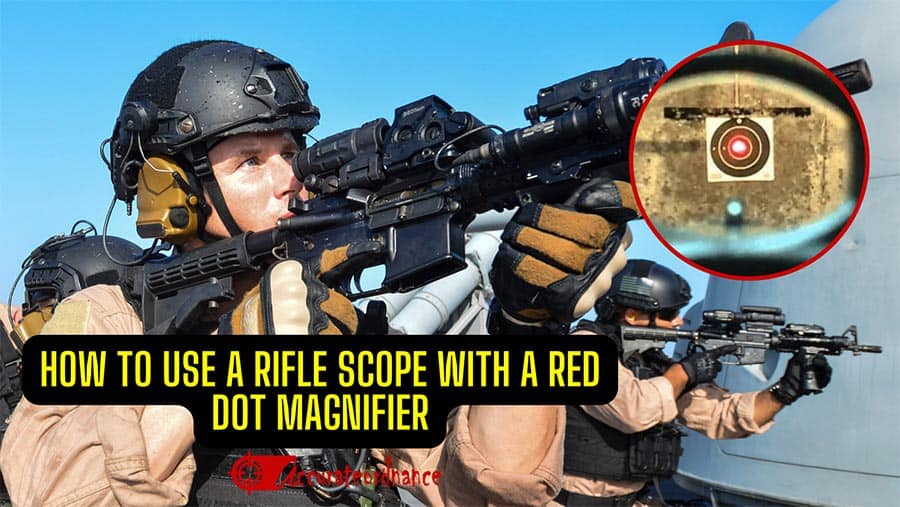
In this article, you’ll find the step-by-step guide on how to set up and use a red dot optic with a red dot magnifier, including tips on proper use and maintenance.
- Red Dot Sight
- Red Dot Magnifier
- Compatibility of red dot sight and red dot magnifier
- Setting Up Red Dot Sight with Red Dot Magnifier
- Proper Use of Red Dot Sight with Red Dot Magnifier
- Mistakes Shooters Make When Using a Magnifier and RDS
- FAQs
- What is a red dot magnifier, and why is it used with a red dot sight?
- What are the advantages of using a red dot magnifier with a red dot sight?
- Are all red dot sights and magnifiers compatible with each other?
- How do I know if my red dot sight and magnifier are compatible?
- What is the proper spacing between the red dot sight and the magnifier?
- How do I adjust the magnification level on the red dot magnifier?
- Can I adjust the focus of the magnifier to make the image clearer?
- Should I wear my glasses while using the magnifier?
- How do I transition between using the red dot sight and the magnifier quickly?
- What type of batteries does the red dot sight use, and how long do they last?
- Can I use the magnifier for hunting, or is it primarily for tactical use?
- Can I use the red dot sight and magnifier combination for long-range shooting?
- What type of mount is suitable for attaching a red dot magnifier?
Red Dot Sight
A red dot sight is a non magnified optic that uses a small illuminated red dot reticle as an aiming point. It is designed to be fast, intuitive, and accurate, allowing the shooter to quickly and easily acquire their target. There are two major types of red dots; reflex sight and holographic sight. Reflex sight can be an open or closed frame, while a holographic sight is usually closed or tube-shaped.
The red dot sight works by reflecting LED light off a partially silvered mirror, which then projects a small illuminated dot onto a coated lens in front of the shooter’s eye. The shooter can see the dot superimposed on the target, allowing them to aim accurately.
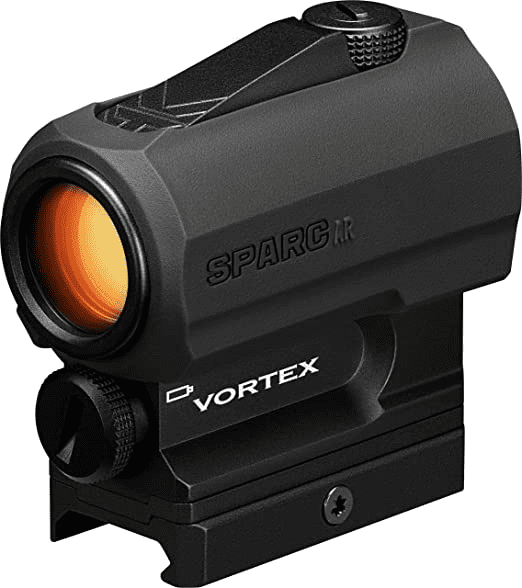
One of the primary advantages of this non magnified optic is its unlimited eye relief. This means that the shooter can maintain their sight picture regardless of their head position, making it an excellent option for shooting with both eyes open. Additionally, the red dot sight is parallax-free, which means that the aiming point remains fixed on the target regardless of the shooter’s head position or eye alignment.
Red dot sights are commonly used for hunting, target shooting, and tactical applications, as they are highly effective in close-quarters combat situations. They are also popular among individuals with visual impairments or those who have difficulty aligning traditional iron sights. Overall, a red dot optic is a highly effective and versatile tool for shooters of all levels, providing quick and accurate aiming capabilities.
Red Dot Magnifier
A magnifier is an accessory that can be attached to a red dot scope to provide additional magnification. It is a small tube-shaped device that mounts directly behind the red dot sight and is designed to be easily and quickly attached and detached as needed.
The magnifier provides a zoom effect that can increase the target’s apparent size, making it easier to aim accurately at longer distances. Magnifiers usually come in magnification levels of 2-4x, although some models may offer more.
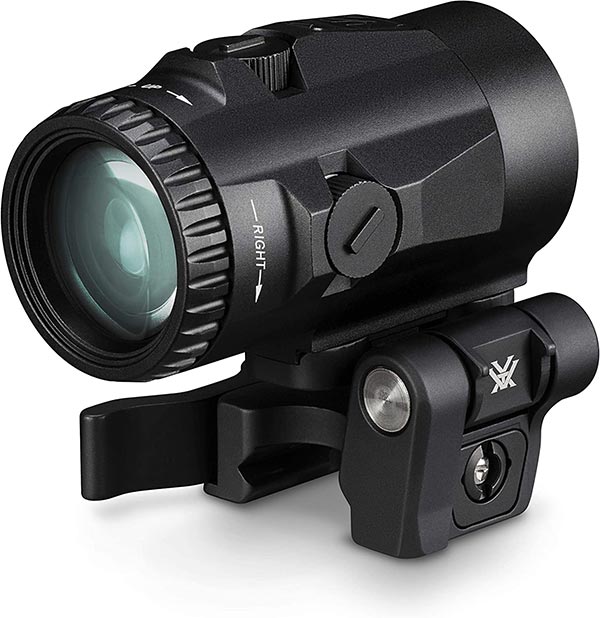
The magnifier works by increasing the size of the image projected by the red dot sight. The shooter can look through the magnifier to see a magnified version of the red dot sight’s reticle, which allows them to aim more precisely at their target.
One of the key advantages of using a magnifier with a red dot sight is that it provides a quick and easy way to transition from close range to medium-range shooting. The shooter can simply flip the magnifier into place when they need additional magnification and then flip it back out of the way when they need to return to close range shooting.
Advantages Of A Magnifier
Let me elaborate further on the advantages of using a magnifier with a red dot sight:
Increased Accuracy
Red dot sights are known for their fast target acquisition and accuracy, but they lack magnification capabilities. When a magnifier is added, it enhances the accuracy even further. The magnification allows the user to see the target more clearly, helping them to aim more precisely and place shots exactly where they need to go. This can be especially useful in competitive shooting or hunting scenarios where a single shot can make all the difference.
Longer Range
Magnifiers can help extend the effective range of a red dot sight. This is useful for shooters who want to take longer-range shots but don’t want to switch to a different sight altogether. With a magnifier, the shooter can see the target more clearly and aim more precisely, even at longer distances. This can also be beneficial in tactical situations where the shooter needs to engage targets at different ranges quickly.
Versatility
Magnifiers can be easily attached or detached from the red dot sight, making them a versatile option for shooters who need both short-range and medium-range capabilities. When a shooter needs to engage targets at a closer range, they can simply remove the magnifier or flip it aside, and when they need to engage targets at longer ranges, they can quickly attach it back to the red dot sight. This saves time and eliminates the need to switch between different sights.
Improved Target Identification
Magnifiers provide greater image quality, making it easier for shooters to identify their targets, especially at longer ranges. This can be especially useful in hunting scenarios where identifying the target accurately can be the difference between a successful or failed hunt. Additionally, in tactical situations where the target is obscured or partially hidden, the magnifier can help identify the target more clearly, giving the shooter a better chance of hitting it.
Compatibility of red dot sight and red dot magnifier
You must understand the compatibility between a red dot scope and a magnifier before using them together. Not all red dot sights and magnifiers are designed to work together, and using incompatible equipment can result in suboptimal performance or even damage to the equipment.
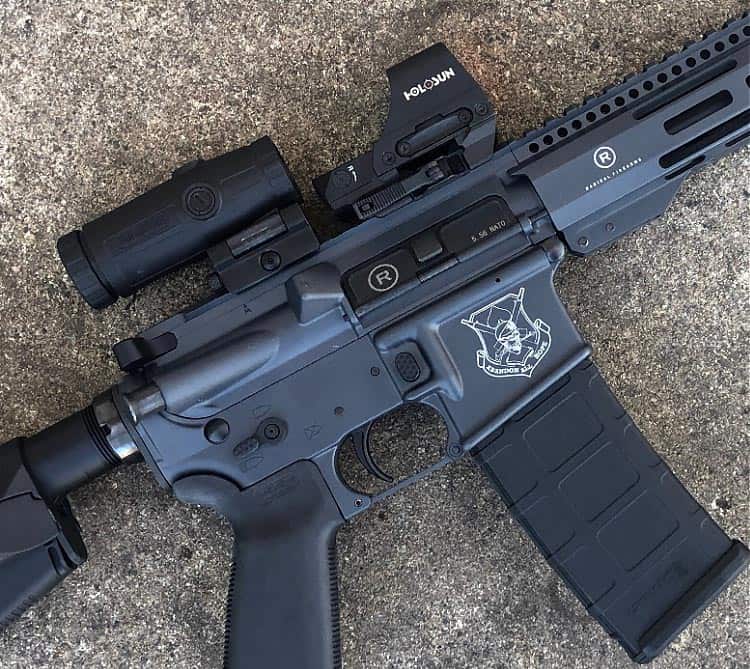
Spacing
One of the most critical factors to consider is the spacing between the red dot sight and the magnifier. Different manufacturers may design their red dot sights and magnifiers with different spacing between them, and if the spacing is not compatible, the shooter will not be able to achieve proper alignment between the two devices.
Mounting System
You must also consider the mounting system used by the red dot sight and the magnifier. Different manufacturers may use different mounting systems, which may not be compatible with each other. It’s important to ensure that both the red dot optic and magnifier use a compatible mounting system to avoid damage to either device.
Lens Size
Another factor to consider is the size of the magnifier’s objective lens. Some magnifiers may have larger objective lenses than others, which can affect the field of view and image clarity when used with a particular red dot sight. It’s important to choose a magnifier with an objective lens that is appropriate for the red dot sight being used.
Setting Up Red Dot Sight with Red Dot Magnifier
Follow this step-by-step guide.
Mount The Red Dot Sight
Mounting the red dot sight is important in setting up a red dot sight with a red dot magnifier. The red dot sight needs to be mounted securely on the firearm to allow for a clear and unobstructed view of the reticle. The process of mounting the red dot sight can vary depending on the firearm and the type of mounting system used.
Most red dot sights come with their own mounting systems, but some may require additional mounting hardware. Following the manufacturer’s instructions and guidelines when mounting the red dot sight is important to ensure proper alignment and secure attachment.
Zero the Red Dot Sight
Zeroing an optic is critical for accurate shooting with any type of sight. The process involves aligning the sight’s reticle with the point of impact on the target at a specific distance. This distance will depend on the firearm and the intended use of the firearm. Since a red dot sight is not used for long range shooting, you may not need to zero beyond 100 yards.
To zero the red dot sight, start by choosing the desired distance and setting up the target. Fire several shots at the target, adjusting the sight’s windage and elevation settings as necessary until the reticle is aligned with the point of impact. It’s important to use consistent shooting techniques, such as the same stance and grip, when zeroing the sight to ensure that the adjustments made accurately reflect the shooter’s aim.
Mount the Magnifier
Mounting the magnifier behind the red dot sight is critical for proper alignment and accuracy. Different mounting systems are available, but the most common types are flip-to-side or quick-detach mounts.

A flip-to-side mount allows the shooter to quickly switch between using the red dot sight and the magnifier by flipping the magnifier to the side. A quick-detach mount allows the shooter to remove the magnifier entirely from the firearm.
To mount the magnifier, first ensure that the mounting system is compatible with both the red dot sight and the magnifier. Then, attach the mount to the magnifier and attach the mount to the firearm according to the manufacturer’s instructions.
Adjust the Spacing
You can’t just mount the magnifier on the setup as you wish; they might not align properly if you do so. Proper spacing between the red dot sight and the magnifier is critical for optimal accuracy and easy transition between the two devices. The spacing will depend on the specific devices being used and the shooter’s preferences.
To adjust the spacing, loosen the mounting system and move the magnifier closer or further away from the red dot sight. Then, tighten the mounting system and ensure that the two devices are aligned. The spacing should allow the shooter to easily and quickly transition between the red dot sight and the magnifier without losing accuracy.
It’s important to test the alignment and spacing by firing several shots at the target and adjusting as necessary. Once the spacing is set, move on to adjusting the magnification level, focus, and eyepiece alignment.
Adjust the Magnification
Most red dot magnifiers come with a 2x or 3x magnification level. There are also magnifiers that have up to 4x or 5x magnification. Meanwhile, very few magnifiers have a variable magnification range of up to 5x, which can be adjusted to suit the shooter’s needs. Adjusting the magnification range is done by rotating the magnifier’s eyepiece or using a dedicated magnification ring, depending on the specific model.
To adjust the magnification, look through the magnifier and rotate the eyepiece or ring until the desired level of magnification is achieved. It’s important to note that increasing the magnification may reduce the field of view and increase eye fatigue.
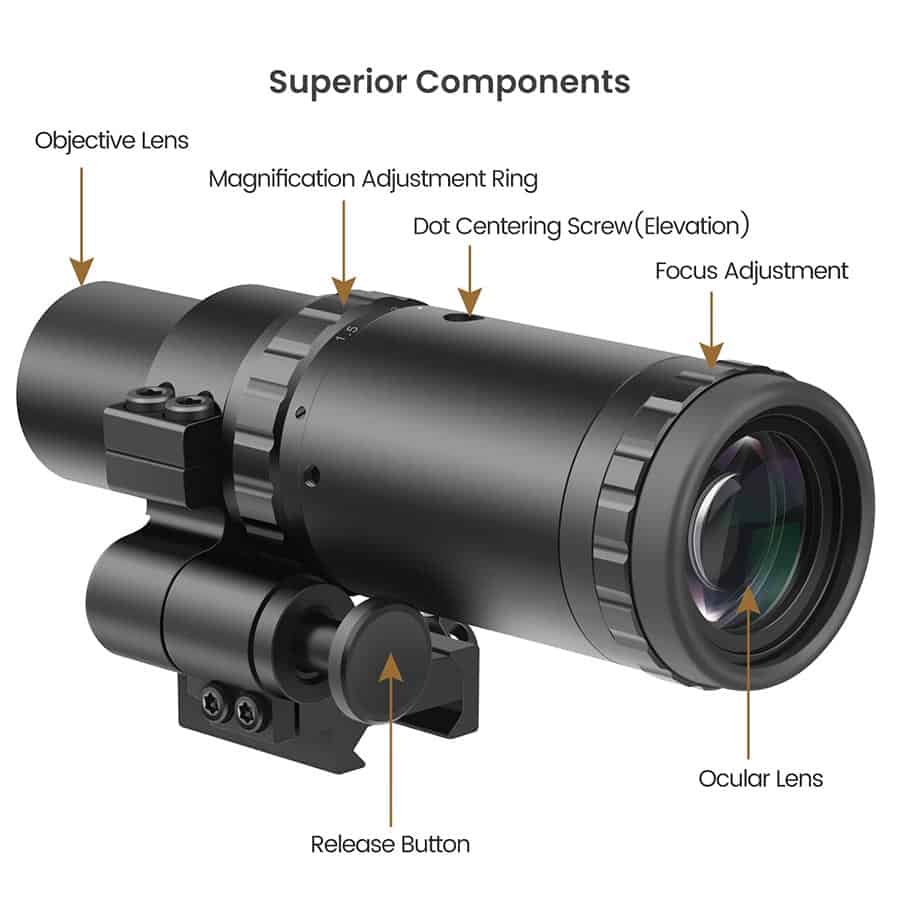
Adjust the Focus
After adjusting the magnification level, the next step is to adjust the focus of the magnifier. This involves aligning the reticle with the target to ensure a clear and sharp image.
To adjust the focus, look through the magnifier at the target and rotate the focus knob until the reticle is clear and sharp. It’s important to note that the focus may need to be adjusted depending on the distance of the target.
Adjust the Eyepiece Alignment
The final step in setting up a red dot sight with a red dot magnifier is to adjust the eyepiece alignment. This ensures that the shooter’s eye is properly aligned with the magnifier for optimal accuracy and comfort.
To adjust the eyepiece alignment, look through the magnifier and rotate the eyepiece until the reticle is in focus and centered in the field of view. This will ensure that the shooter’s eye is properly aligned with the magnifier and that the reticle remains in the same position when transitioning between the red dot sight and the magnifier.
It’s important to test the alignment and adjustments by firing several shots at the target and adjusting as necessary. Once the magnifier is properly set up, the shooter can enjoy the benefits of increased magnification and accuracy for a variety of shooting applications.
Proper Use of Red Dot Sight with Red Dot Magnifier
After the red dot sight and magnifier have been set up, it’s important to understand how to use them together effectively to get the most out of the system.
One of the most important aspects of using a red dot sight with a red dot magnifier is knowing when and how to transition between the two. The red dot sight is typically used for close to mid-range engagements, while the magnifier is used for long range shooting that requires more accuracy and precision.
When transitioning between the red dot sight and the magnifier, you should do so quickly and smoothly to avoid losing sight of the target. This requires practice and familiarity with the system. The shooter should also be aware of their eye relief, as moving too close or far from the magnifier can cause the reticle to appear blurry or out of focus.
Another important aspect of using a red dot sight with a red dot magnifier is to be aware of the system’s limitations. While the magnifier can increase magnification and accuracy, it adds weight and bulk to the firearm. Additionally, the increased magnification may not be necessary or useful in certain shooting situations, such as close-quarters combat.
It’s also important to regularly maintain and inspect the red dot sight and magnifier to ensure they are properly functioning and securely attached to the firearm. This includes checking for any damage or wear and tear, cleaning the lenses, and replacing batteries as needed.
By understanding how to properly use a red dot sight with a red dot magnifier, shooters can enhance their accuracy and precision in a variety of shooting situations.
Mistakes Shooters Make When Using a Magnifier and RDS
Here are some common mistakes that shooters might make when using a red dot sight with a magnifier and how to fix them.
Eye Relief Mistake
Eye relief is crucial when using a magnifier to maintain a clear and sharp image. If your eye is too close or too far from the magnifier, the image might become fuzzy or even cut-off. This is because the magnifier is designed to provide the best image when your eye is positioned at a specific distance from the lens.
To fix this, take your time to find the right eye relief distance. First, ensure that your red dot sight and magnifier are correctly mounted and aligned on your firearm. Then, when you look through the magnifier, experiment by slightly moving your head forward or backward until you see a clear and sharp image. It might take a few adjustments, but when you find the sweet spot, remember that position and try to maintain it consistently while shooting.
Misalignment Problem
Proper alignment between the red dot sight and the magnifier is essential for accurate aiming. If the red dot does not appear in the center of your view when using the magnifier, it might not be aligned correctly.
To solve this, first, check the spacing between the red dot sight and the magnifier. Some magnifiers come with adjustable mounts or shims to help achieve the right spacing. Adjust the mount if needed to make sure the red dot is right in the middle of the magnified image. This alignment is crucial to ensure that when you aim using the red dot, it corresponds accurately to where your shot will hit.
Focus Issue
Achieving a sharp and clear image is vital for precise shooting. If you notice that the reticle or the target looks blurry when using the magnifier, it might be a focus problem.
To address this problem, locate the focus knob on your magnifier. Slowly and carefully turn the focus knob until the image becomes clear and crisp. Take your time with this adjustment, as it ensures you have a precise sight picture for accurate shooting. If you wear glasses, it’s essential to keep them on while using the magnifier. Your glasses help correct your vision, and using them while looking through the magnifier can enhance your focus and overall sight clarity.
Flipping Trouble
Flipping the magnifier aside quickly when you want to use only the red dot sight can be challenging for some shooters, especially if they are not accustomed to the motion. It takes practice and muscle memory to execute the flip smoothly and efficiently.
To fix this, dedicate some time during your practice sessions to specifically work on flipping the magnifier in and out of the way. Start by doing slow and deliberate flips, focusing on the proper technique and movement. Gradually increase the speed as you become more comfortable with the motion. As you practice, pay attention to the positioning of your hand and the amount of force needed to flip the magnifier. You want to find the right balance so that it flips aside effortlessly but also locks securely in place when not in use.
Battery Check
Regularly checking the batteries in your red dot sight is essential to ensure that the illuminated red dot remains visible and functional. A low or dead battery can render the red dot sight ineffective, making the magnifier useless as well.
To avoid dead batteries, make it a habit to check the batteries before every shooting session. Create a checklist for your pre-shooting routine, and include checking the battery level in the red dot sight. If the battery is low or nearing its end, replace it with a fresh one to ensure optimal performance. Consider keeping spare batteries in your shooting gear or range bag so that you’re always prepared to replace them when needed. This simple habit can prevent frustrating experiences during shooting sessions and keep your optics running smoothly.
Focusing on the Wrong Target
When using a magnifier, it’s important to remember that it can make objects appear larger than they actually are. This can lead to inadvertently focusing on unintended targets, especially in busy or cluttered shooting environments.
To fix this, always double-check your target through the magnifier before taking any shots. Take a moment to positively identify your intended target and confirm that it’s safe and appropriate to engage. Practicing target discrimination and being aware of your surroundings will help you avoid accidentally shooting something you shouldn’t.
Over-reliance on Magnification
While the magnifier provides valuable zoom for longer-range shots, relying on it for every shot, especially at close ranges, can hinder your performance. The red dot sight alone is designed for quick target acquisition and excels in close-quarters engagements.
Use the magnifier selectively when you need the extra magnification for longer-distance shooting. At close ranges, trust the red dot sight to perform its job effectively. Practicing target transitions and engaging in drills that simulate different shooting scenarios will help you develop the instinct to switch between the two optics appropriately.
FAQs
What is a red dot magnifier, and why is it used with a red dot sight?
A red dot magnifier is a small tube-shaped accessory that attaches to a red dot sight. It provides additional magnification, like a mini telescope, which makes far-away targets appear closer and larger. It is used with a red dot sight to help shooters aim more accurately at longer distances while still enjoying the quick target acquisition benefits of the red dot sight at close ranges.
What are the advantages of using a red dot magnifier with a red dot sight?
Using a red dot magnifier with a red dot sight has several advantages. Firstly, it increases accuracy by making distant targets clearer and easier to aim at. Secondly, it allows shooters to quickly switch between close and far targets without changing optics, saving time. Lastly, the magnifier enhances versatility by providing different aiming options for various shooting scenarios.
Are all red dot sights and magnifiers compatible with each other?
Not all red dot sights and magnifiers are compatible with each other. Different manufacturers design their optics with varying specifications and mounting systems.
How do I know if my red dot sight and magnifier are compatible?
To determine compatibility, check the specifications and mounting systems of both the red dot sight and the magnifier. Many manufacturers provide information on which models are designed to work together.
What is the proper spacing between the red dot sight and the magnifier?
There’s no hard rule or measure for the spacing. The exact spacing can vary depending on the specific models of the red dot sight and magnifier you are using.
How do I adjust the magnification level on the red dot magnifier?
Adjusting the magnification level on the red dot magnifier is typically straightforward. Although most magnifiers come with a fixed magnification, such as 2x or 3x, and do not require any adjustments. However, some models have a variable magnification range, allowing you to adjust the zoom level. To do this, look for a dedicated magnification ring or knob on the magnifier, and rotate it to your desired level of magnification.
Can I adjust the focus of the magnifier to make the image clearer?
Yes, most red dot magnifiers allow you to adjust the focus to make the image clearer. To do this, look for a focus knob on the magnifier. By rotating the focus knob, you can sharpen the image and ensure both the reticle and the target appear crisp and in focus. Adjust the focus until the image looks sharp and clear to improve your aiming precision.
Should I wear my glasses while using the magnifier?
Whether or not you should wear glasses while using the magnifier depends on your eyesight. If you normally wear glasses for clearer vision, it is recommended to keep them on while using the magnifier. Wearing your glasses will help correct any vision issues, ensuring you get the full benefit of the magnification and maintain a clear sight picture. However, if you don’t normally wear glasses or your vision is not significantly impaired, you may not need them while using the magnifier.
How do I transition between using the red dot sight and the magnifier quickly?
Transitioning between using the red dot sight and the magnifier quickly requires practice and familiarity with your setup. You should develop muscle memory to flip the magnifier aside smoothly when you want to use only the red dot sight.
What type of batteries does the red dot sight use, and how long do they last?
The type of batteries used in red dot sights varies depending on the model. Commonly, red dot sights use small batteries like CR2032 or CR1632. These batteries are readily available and easy to find in stores. The battery life can vary based on factors such as the brightness setting used and the specific sight’s efficiency. On average, these batteries can last from several hundred to thousands of hours of continuous use.
Can I use the magnifier for hunting, or is it primarily for tactical use?
The red dot magnifier is versatile and can be used for both hunting and tactical purposes. It provides the advantage of enhanced accuracy at longer distances, making it useful for hunting when precise shots are needed. However, you should note that magnifiers can only be mounted on rifles that have a platform like AR-15. If you hunt with a bolt action rifle, you will not be able to mount a magnifier easily.
Can I use the red dot sight and magnifier combination for long-range shooting?
No, the red dot sight and magnifier combination cannot be used for long-range shooting. It can only be used for medium-distance shots. While the magnifier provides additional magnification, it might not be as powerful as dedicated long-range scopes.
What type of mount is suitable for attaching a red dot magnifier?
Most red dot magnifiers usually come with their own quick-detach mount or flip mount.

Mike Hardesty is a published freelance gun writer. He also possesses specialized expertise in rifle scopes With dozens of articles and reviews published in Pew Pew Tactical, Snipercountry.com, and TTAG (The Truth About Guns), Mike is considered a firearms expert. His special area of expertise is handguns.
Mike is a long-time shooter. He has been punching paper targets, taking deer and other game and shooting at competitions since about 1975. Other related pursuits include reloading and bullet casting. He currently reloads for over 10 calibers, both handgun and rifle. His reloads, particularly for 9mm, were in great demand during the height of the ammo shortage among family and friends. He donated hundreds of rounds to informal shooting sessions. He was quoted as saying “I do not sell my reloads but I sure will help my guys shoot ’em for free!”. He has a few cherished firearms that he has inherited or otherwise procured — those are his favorites.
He earned B.S. and M.S. degrees from Indiana State University in 1974-1975.
He’s a firearm experts and is the founder of mhardesty.com.
